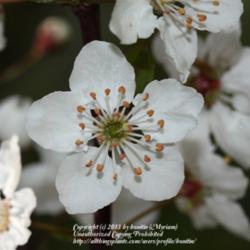
The cherries sold fresh in most markets are sweet cherries -they have a thick, rich, almost plumlike texture and sweet taste. If you like your cherries cooked, then you have probably eaten tart cherries, which are juicier and slightly sour. While sweet cherries certainly have their virtues, tart cherries are delicious in preserves and pies and are much easier to grow. Although sweet and tart cherries have very similar growing requirements and are subject to the same pests, tart cherries are more tolerant of cold winters and long, hot, humid summers and have fewer disease problems.
The tart cherry trees are smaller so they are easier to harvest, prune, and spray. There are many varieties of sweet and tart cherries that are self-fertile, so you can plant just one tree and still harvest fruit. Why not start with one beautiful tart cherry tree to enhance your edible landscape? In time, perhaps you'll want to add more tart cherries or, if you have the right growing conditions, add some sweet cherry trees.
Choosing and Planning CherriesTart Varieties
Tart cherry trees are ornamental, and the fruit makes wonderful pies, cobblers, and toppings. To get the most from your trees, start with varieties suitable for your climate and look for certified virus-free trees. Tart cherries are hardy in USDA Hardiness Zones 4 through 6. The standard-size 'Montmorency' has been the leading tart cherry variety for many years. It yields heavy crops of large, bright red, high-quality tart cherries in mid- to late June (in zone 6). The tree is available on a semidwarfing rootstock, which produces a tree two-thirds standard size, as well as on standard-size rootstock.
Several genetic dwarf varieties are available. These are naturally small and can be grafted onto the standard rootstocks. They include several spur-type 'Montmorency' sports (varieties that arise from a bud mutation) and 'Meteor', all semidwarfs, and 'North Star', a full dwarf.
Sweet Varieties
Sweet cherries aren't for everyone, but for those willing to choose varieties carefully, prune and spray regularly, and deal with marauding birds, the rewards are great. Choosing varieties adapted to your area and resistant to its major diseases is critical. Most sweet cherry varieties are hardy in zones 5 through 7; in colder zones, choose varieties with the hardiest wood and buds. A few sweet cherry varieties resist the problems that plague most sweet cherries- fruit cracking, brown rot, and cherry leaf spot. Some are very hardy, a few are only mildly attractive to birds, and some are self-fertile and genetically dwarfed.
Some of the traditional cherry favorites such as 'Bing' have their drawbacks, especially concerning disease susceptibility. In most areas, stay clear of most commonly sold varieties. 'Bing' can be grown successfully on the West Coast where winters are mild and dry air makes fruit cracking and brown rot less of a problem, but seldom does well in the East. Even where 'Bing' can be grown, there are better varieties for home gardeners. 'Starkcrimson' is a self-fertile genetic dwarf with bigger, sweeter fruit. 'Compact Stella' another self-fertile sweet variety. 'Glacier' produces large, mahogany red fruit in midseason. While there are some self fertile sweet cherry varieties, most should be grown with at least one other compatible variety near by to insure proper pollination.
Which rootstock the variety is growing on will make a difference in its performance and hardiness. Cherry rootstock varieties include 'Mazzard','Mahaleb', and 'Gisele'. These not only dwarf a cherry tree, but also provide disease resistance and better performance in poor soils. Choose a rootstock compatible with your variety and one recommended for your soils and climate.
 Victory Seed Company has all the seeds you want for your best garden in 2024.
Victory Seed Company has all the seeds you want for your best garden in 2024.
For 25 years, the family-owned Victory Seed Company has provided the highest quality vegetable, herb and flower seeds to families across the country. We are passionate about providing you the best seeds available that give excellent germination, robust plants, and the harvest you want. With a catalog of over a thousand varieties, we have everything, and our prices are the kinds that we'd want to pay. We have hundreds of yesterday's heirloom vegetables, as well as today's award winning hybrid selections. Get to know us by visiting our website and browsing through our online vegetable seed catalog.
| 1. Cherry Essentials |
| 2. Planting Cherries |
| 3. Cherry Varieties ← you're on this article right now |
| 4. Cherry Care & Harvesting |
| 5. Preventing Birds on Cherry Trees |
| 1. Cherry Essentials |
| 2. Planting Cherries |
| 3. Cherry Varieties ← you're on this article right now |
| 4. Cherry Care & Harvesting |
| 5. Preventing Birds on Cherry Trees |